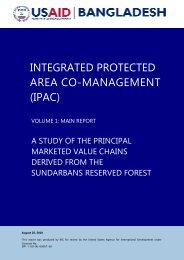Child Equity Atlas - BIDS
Child Equity Atlas - BIDS
Child Equity Atlas - BIDS
You also want an ePaper? Increase the reach of your titles
YUMPU automatically turns print PDFs into web optimized ePapers that Google loves.
<strong>Child</strong> <strong>Equity</strong> <strong>Atlas</strong><br />
4.2.3 To effectively address the issues of child<br />
labour and real child worker, it is important to<br />
understand the structural issues that underpin<br />
this practice. According to UNICEF 19 , social norms<br />
and economic realities mean that child labour is<br />
widely accepted and very common in Bangladesh.<br />
Many families rely on the income generated by<br />
their children for survival, so child labour is often<br />
highly valued. Additionally, employers often prefer<br />
to employ children because they are cheaper and<br />
considered to be more compliant and obedient<br />
than adults.<br />
4.2.4 Taking advantage of its progress towards<br />
the MDGs 2 and 3 while focusing on equity<br />
requires that by 2021, the country’s middle<br />
income aspirations be gauged by reduction in the<br />
prevalence of the real child worker, compliance<br />
of services and industries to the provisions of<br />
ILO Conventions 138 and 182 as well as how the<br />
socioeconomic rights of children are guaranteed<br />
through effective coverage of education that<br />
leaves no room for out of school children, hence<br />
producing quality human capital for services and<br />
industry at home and abroad.<br />
19<br />
UNICEF Bangladesh, 2010. <strong>Child</strong> Labour in Bangladesh:<br />
http://www.unicef.org/bangladesh/<strong>Child</strong>_labour.pdf<br />
Photo : Ibrahim Khan Moni<br />
60














